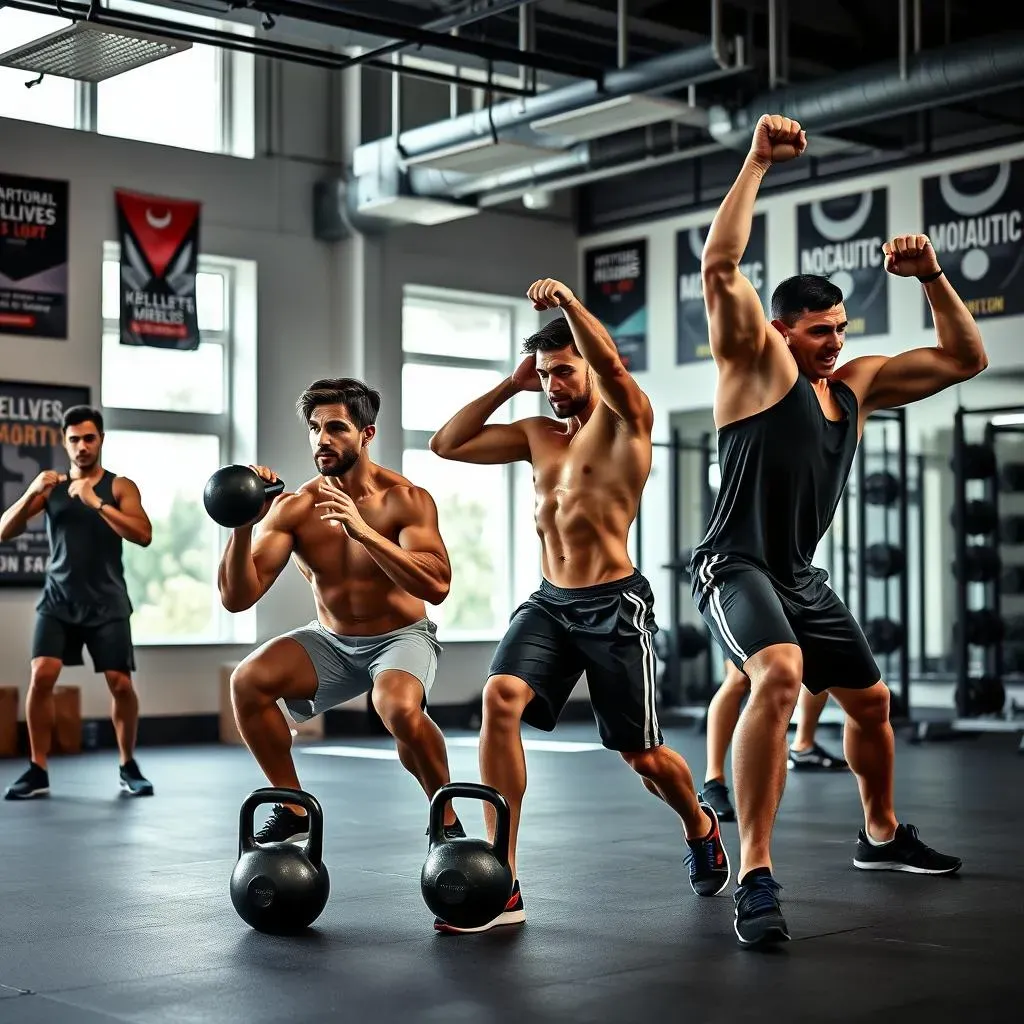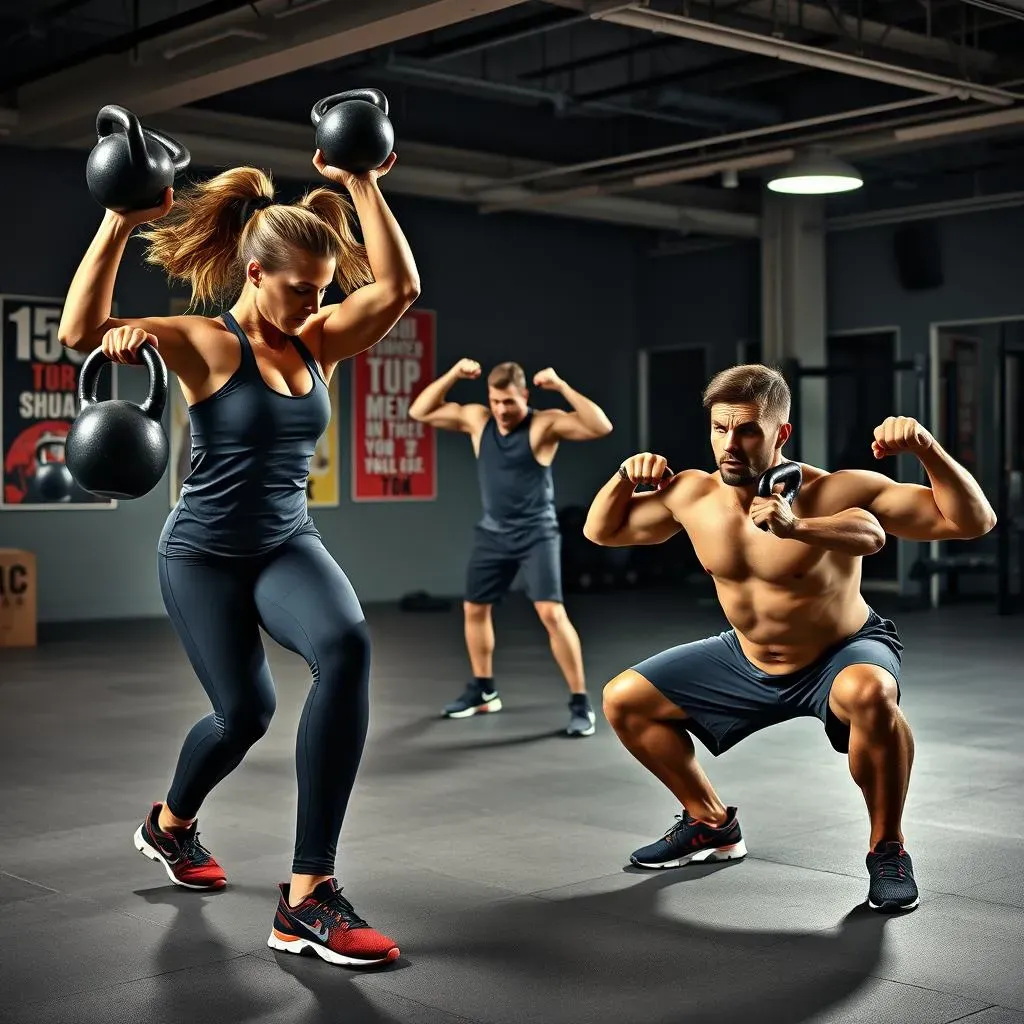Table of Contents
Ready to ditch the boring gym routine and unlock a powerhouse of strength, endurance, and fat-burning potential? Forget endless hours on the treadmill and complicated weight machines. The answer lies in one simple, yet incredibly effective tool: the kettlebell. This article dives deep into the world of kettlebells, offering you a comprehensive guide to crafting your own effective full body kettlebell workout routine. We'll explore the foundational movements, build a 4-day workout plan that torches calories and sculpts muscle, and teach you the proper techniques to maximize results while minimizing risk. Whether you're a seasoned athlete or just starting your fitness journey, prepare to discover how a kettlebell can transform your body and redefine your limits. Get ready to swing, snatch, and press your way to a stronger, leaner, and more athletic you. Let's get started!
Master the Kettlebell Swing: The Foundation of Your Full Body Workout

Master the Kettlebell Swing: The Foundation of Your Full Body Workout
Why the Kettlebell Swing is King
So, you're looking to get into kettlebells? Awesome! Seriously, you've picked a fantastic tool for a full-body blast. But before you start trying to snatch or clean a bell, let's talk about the king of all kettlebell exercises: the swing. It's not just another exercise; it's the foundation upon which almost everything else is built. Think of it as the ABCs of kettlebell training.
Why is it so crucial? Because the kettlebell swing teaches you the fundamental movement patterns you'll use in more complex exercises. It’s all about the hip hinge, generating power from your glutes and hamstrings, and maintaining a strong, stable core. Nail the swing, and you'll unlock a whole new level of strength and athleticism. Plus, it's a killer cardio exercise that'll leave you breathless in the best way possible.
I remember when I first started with kettlebells, I was eager to jump into the fancy stuff. But a seasoned trainer stopped me and said, "Master the swing, and the rest will follow." He was absolutely right. Once I focused on perfecting my swing technique, everything else became easier and more effective.
Breaking Down the Kettlebell Swing Technique
Alright, let's get down to the nitty-gritty of the kettlebell swing. It’s more than just flailing your arms and hoping for the best. Proper form is key to preventing injuries and maximizing the benefits. Here's a step-by-step breakdown:
- Stance: Stand with your feet slightly wider than shoulder-width apart, with the kettlebell a few inches in front of you.
- Grip: Hinge at your hips, keeping your back straight, and grab the kettlebell with both hands. Your palms should be facing down.
- The Hike: Hike the kettlebell back between your legs, like you're hiking a football. This is your backswing.
- The Drive: Explosively drive your hips forward, squeezing your glutes and straightening your body. The kettlebell should swing up to about chest height.
- The Float: At the top of the swing, let the kettlebell float for a brief moment. This is where you're fully extended.
- The Return: Allow the kettlebell to swing back down between your legs, hinging at your hips to absorb the momentum.
- Repeat: Repeat the movement for the desired number of repetitions.
The most common mistake I see is people using their arms to lift the kettlebell. Remember, the power comes from your hips and glutes, not your arms. Your arms are just there to guide the kettlebell.
Common Mistakes and How to Fix Them
Even with the best instructions, it's easy to fall into some common traps when learning the kettlebell swing. Here are a few mistakes I see all the time, along with tips on how to correct them:
Mistake | How to Fix It |
|---|---|
Rounding the back | Focus on maintaining a straight back throughout the movement. Engage your core and keep your chest up. |
Squatting instead of hinging | Think of pushing your hips back, like you're closing a car door with your butt. |
Using your arms too much | Focus on generating power from your hips and glutes. Your arms should be relaxed. |
Not fully extending at the top | Squeeze your glutes and fully extend your hips at the top of the swing. |
Looking down | Keep your gaze forward to maintain a neutral spine. |
Don't get discouraged if you don't get it right away. It takes practice and patience to master the kettlebell swing. Focus on proper form, and the results will come.
I remember struggling with the hip hinge at first. I kept squatting down instead of pushing my hips back. It wasn't until I filmed myself and saw what I was doing wrong that I was able to correct my form. So, don't be afraid to record yourself and analyze your technique.
Full Body Kettlebell Workout Routine: A 4Day Strength and Cardio Plan

Full Body Kettlebell Workout Routine: A 4Day Strength and Cardio Plan
now that you've got the swing down, let's talk about putting together a full body kettlebell workout routine. I'm a big believer in a structured approach, especially when you're starting out. This 4-day plan is designed to hit every major muscle group, build strength, and get your heart pumping. We'll alternate between two different workouts, hitting them twice a week each, with rest days in between to allow your body to recover and rebuild. Remember, consistency is key. Stick with this plan for a few weeks, and you'll start to see some serious results. I've seen people transform their physiques and their fitness levels with just this simple routine.
Kettlebell Exercises for a Full Body Transformation: Technique and Form

Kettlebell Exercises for a Full Body Transformation: Technique and Form
Goblet Squats: Your Foundation for Leg Strength
Alright, let's talk about building serious leg strength with kettlebells. And what better place to start than the goblet squat? This exercise is fantastic because it not only builds strength in your quads, glutes, and hamstrings, but it also improves your core stability and posture. Think of it as a squat with a built-in counterbalance. The kettlebell helps you maintain a more upright torso, which is crucial for proper form and preventing injuries. I often recommend this exercise to beginners because it teaches them how to squat correctly.
To perform a goblet squat, hold the kettlebell close to your chest, like you're cradling a baby. Stand with your feet slightly wider than shoulder-width apart, toes slightly pointed out. Keeping your back straight and your core engaged, squat down as low as you can while maintaining good form. Your elbows should track inside your knees. Then, push through your heels to return to the starting position. Focus on controlled movements and proper breathing. Inhale as you squat down, and exhale as you stand up.
Kettlebell Clean and Press: Power and Strength Combined
Ready to take things up a notch? The kettlebell clean and press is a dynamic exercise that combines power, strength, and coordination. It works your entire body, from your legs and core to your shoulders and arms. This is one of those exercises that makes you feel like a total badass when you nail it. It requires practice and attention to detail, but the payoff is well worth the effort. I've seen people build incredible upper body strength with just this one exercise.
The clean involves lifting the kettlebell from the ground to the racked position, where the kettlebell rests on your forearm, close to your chest. The press then involves pressing the kettlebell overhead, fully extending your arm. The key is to use your legs and hips to generate power, rather than relying solely on your upper body strength. The kettlebell should feel weightless at the top of the clean, and the press should be smooth and controlled. Start with a lighter weight and focus on mastering the technique before progressing to heavier loads.
Kettlebell Turkish Get-Up: The Ultimate Test of Full-Body Control
If you're looking for a challenge that will test your strength, stability, and coordination, look no further than the kettlebell Turkish get-up. This exercise is a true test of full-body control. It involves transitioning from lying on the ground to standing upright, all while holding a kettlebell overhead. It's a slow, deliberate movement that requires focus and precision. I often describe it as a moving meditation.
The Turkish get-up is not an exercise to be rushed. Each step should be performed with intention and control. Start by lying on your back with the kettlebell in one hand, arm extended straight up. Bend the knee on the same side as the kettlebell. Then, slowly transition through a series of movements, using your core and legs to support your body. The goal is to maintain a stable base and keep the kettlebell directly overhead throughout the entire movement. The Turkish get-up is a complex exercise, so it's best to learn it under the guidance of a qualified instructor.
Exercise | Primary Muscles Worked | Benefits |
|---|---|---|
Goblet Squats | Quads, Glutes, Hamstrings, Core | Builds leg strength, improves core stability, enhances posture |
Kettlebell Clean and Press | Legs, Core, Shoulders, Arms | Develops power, strength, and coordination |
Kettlebell Turkish Get-Up | Full Body | Improves strength, stability, coordination, and mental focus |
Advanced Kettlebell Moves: Taking Your Full Body Workout to the Next Level

Advanced Kettlebell Moves: Taking Your Full Body Workout to the Next Level
So, you've mastered the basics: the swing, the goblet squat, the clean and press. You're feeling stronger, fitter, and more confident. What's next? It's time to crank things up a notch and explore some advanced kettlebell movements that will challenge your body and mind in new ways. These aren't just about adding weight; they're about refining your technique, improving your stability, and unlocking a whole new level of athletic performance. Think of it as taking your full body kettlebell workout routine from 2D to 3D. These moves require a solid foundation, so make sure you're comfortable with the basics before diving in. Trust me, the rewards are worth the effort. I remember when I first started experimenting with these advanced moves, it felt like I was learning kettlebells all over again. It was humbling, challenging, and incredibly rewarding.
Ready to push your limits? Let's dive into some advanced kettlebell exercises that'll take your full-body workout to the next level.
Kettlebell Snatch: Unleash Explosive Power
let's talk about one of the most impressive and challenging kettlebell exercises out there: the snatch. This move is all about explosive power, coordination, and precision. It's not just about lifting the kettlebell overhead; it's about doing it with speed, efficiency, and control. The kettlebell snatch is a full-body exercise that works your legs, hips, core, shoulders, and arms. It's a fantastic way to build strength, power, and endurance. But fair warning: it's also a technical exercise that requires practice and patience. I remember the first time I tried the snatch, I felt like a total klutz. It took me weeks of practice to get the technique down, but once I did, it was like unlocking a new superpower.
The kettlebell snatch involves lifting the kettlebell from the ground to the overhead position in one smooth, continuous motion. The key is to use your hips and legs to generate power, rather than relying solely on your upper body strength. The kettlebell should feel weightless at the top of the movement, and your arm should be locked out. The snatch requires a strong grip, a stable core, and excellent timing. Start with a lighter weight and focus on mastering the technique before progressing to heavier loads. Don't be afraid to break the movement down into smaller steps and practice each step individually. The snatch is a challenging exercise, but with practice and persistence, you can master it.
Kettlebell Windmill: Stability and Core Strength
Now, let's shift gears and talk about an exercise that's all about stability, core strength, and flexibility: the kettlebell windmill. This move is a slow, deliberate, and controlled movement that requires focus and precision. It's not about lifting heavy weight; it's about maintaining balance and control while rotating your torso. The kettlebell windmill is a fantastic exercise for improving core stability, shoulder mobility, and hamstring flexibility. It's also a great way to challenge your balance and coordination. I often recommend this exercise to people who are looking to improve their posture and prevent injuries.
The kettlebell windmill involves standing with your feet slightly wider than shoulder-width apart, holding a kettlebell overhead in one hand. Keeping your arm straight and your gaze fixed on the kettlebell, slowly hinge at your hips and lower your opposite hand towards the ground. The goal is to maintain a straight line from your hand holding the kettlebell to your opposite hand on the ground. The windmill requires a strong core, flexible hamstrings, and excellent balance. Start with a lighter weight and focus on mastering the technique before progressing to heavier loads. Don't be afraid to modify the movement to suit your individual needs and abilities. The windmill is a challenging exercise, but with practice and patience, you can reap its many benefits.
Exercise | Primary Muscles Worked | Benefits |
|---|---|---|
Kettlebell Snatch | Full Body | Develops explosive power, strength, and coordination |
Kettlebell Windmill | Core, Shoulders, Hamstrings | Improves stability, core strength, and flexibility |
Double Kettlebell Front Squat: Maximize Strength
Want to seriously test your leg and core strength? Then you need to try the double kettlebell front squat. This exercise takes the goblet squat to a whole new level by doubling the weight and challenging your stability even further. Holding two kettlebells in the front rack position demands serious core engagement to keep you upright, while your quads, glutes, and hamstrings work overtime to power through each rep. This isn’t just about building muscle; it’s about forging serious mental toughness. I remember the first time I tried double kettlebell front squats, I was surprised by how much harder they were than single kettlebell squats. It's a humbling experience, but one that will make you stronger and more resilient.
To perform the double kettlebell front squat, clean two kettlebells into the front rack position, resting on your forearms. Stand with your feet slightly wider than shoulder-width apart, toes slightly pointed out. Keeping your back straight and your core engaged, squat down as low as you can while maintaining good form. Your elbows should track inside your knees. Then, push through your heels to return to the starting position. Focus on controlled movements and proper breathing. Inhale as you squat down, and exhale as you stand up. The double kettlebell front squat requires a solid foundation of strength and stability, so make sure you're comfortable with the single kettlebell version before attempting this exercise.
Fueling Your Full Body Kettlebell Workout Routine: Nutrition and Recovery

Fueling Your Full Body Kettlebell Workout Routine: Nutrition and Recovery
The Importance of Nutrition for Kettlebell Training
Alright, so you're crushing those kettlebell workouts, swinging, cleaning, and snatching like a pro. But are you fueling your body properly? Because let me tell you, nutrition is just as important as the training itself. You can't expect to build muscle, burn fat, and recover effectively if you're running on empty. Think of your body as a high-performance machine. You wouldn't put cheap gas in a Ferrari, would you? The same goes for your body. You need to provide it with the right nutrients to perform at its best. I've seen so many people sabotage their progress by neglecting their nutrition. They work hard in the gym, but then they eat junk food and wonder why they're not seeing results. Don't let that be you!
Fueling your full body kettlebell workout routine means focusing on whole, unprocessed foods that provide your body with the energy and nutrients it needs to thrive. That means plenty of lean protein, complex carbohydrates, healthy fats, and lots of fruits and vegetables. These foods provide your body with the building blocks it needs to repair muscle tissue, replenish glycogen stores, and support overall health. And don't forget about hydration! Water is essential for every bodily function, including muscle contraction and nutrient transport. Aim to drink plenty of water throughout the day, especially before, during, and after your workouts.
Macronutrient Breakdown: Protein, Carbs, and Fats
Let's break down the macronutrients and talk about how they contribute to your kettlebell training. Protein is essential for muscle repair and growth. Aim to consume at least 0.8 grams of protein per pound of body weight per day. Good sources of protein include lean meats, poultry, fish, eggs, dairy products, and plant-based sources like beans, lentils, and tofu. Carbohydrates are your body's primary source of energy. Choose complex carbohydrates like whole grains, fruits, and vegetables over simple carbohydrates like sugary drinks and processed snacks. Healthy fats are important for hormone production, cell function, and overall health. Include sources of healthy fats like avocados, nuts, seeds, and olive oil in your diet.
The timing of your meals is also important. Aim to eat a meal or snack containing protein and carbohydrates within an hour after your workout to help replenish glycogen stores and repair muscle tissue. A protein shake with a banana is a convenient and effective option. Before your workout, focus on consuming slow-digesting carbohydrates to provide sustained energy throughout your training session. Oatmeal with berries and nuts is a great choice.
Recovery Strategies: Rest, Sleep, and Active Recovery
Finally, let's talk about recovery. Because even with the best nutrition, you won't see results if you're not allowing your body to recover properly. Rest and sleep are essential for muscle repair and growth. Aim to get at least 7-8 hours of sleep per night. Create a relaxing bedtime routine to help you wind down before bed. Avoid screen time in the hour before bed, and make sure your bedroom is dark, quiet, and cool.
Active recovery can also help speed up the recovery process. This involves performing low-intensity exercises like walking, swimming, or yoga on your rest days. Active recovery helps to increase blood flow to your muscles, which can help to reduce inflammation and promote healing. Listen to your body and don't overdo it. The goal is to feel better, not worse. If you're feeling sore or fatigued, take a day off and allow your body to fully recover. Remember, consistency is key. Stick with your full body kettlebell workout routine, fuel your body properly, and prioritize recovery, and you'll be amazed at the results you can achieve.
Recovery Strategy | Benefits |
|---|---|
Rest and Sleep | Muscle repair and growth, hormone regulation |
Active Recovery | Increased blood flow, reduced inflammation |
Conclusion: Swing into Action with Your Full Body Kettlebell Workout Routine
You've now got the knowledge and the plan – it's time to put it into action. This full body kettlebell workout routine is your roadmap to a stronger, leaner, and more powerful you. Remember to prioritize proper form, listen to your body, and progressively challenge yourself. The kettlebell is more than just a weight; it's a tool for transformation. Embrace the challenge, stay consistent, and watch as your strength, endurance, and overall fitness reach new heights. So pick up that kettlebell and swing your way to a healthier, more resilient you!